
The LGBT community is a loosely defined grouping of lesbian, gay, bisexual, and transgender individuals united by a common culture and social movements. These communities generally celebrate pride, diversity, individuality, and sexuality. LGBT activists and sociologists see LGBT community-building as a counterweight to heterosexism, homophobia, biphobia, transphobia, sexualism, and conformist pressures that exist in the larger society. The term pride or sometimes gay pride expresses the LGBT community's identity and collective strength; pride parades provide both a prime example of the use and a demonstration of the general meaning of the term. The LGBT community is diverse in political affiliation. Not all people who are lesbian, gay, bisexual, or transgender consider themselves part of the LGBT community.

Urvashi Vaid was an Indian-born American LGBT rights activist, lawyer, and writer. An expert in gender and sexuality law, she was a consultant in attaining specific goals of social justice. She held a series of roles at the National LGBTQ Task Force, serving as executive director from 1989-1992 — the first woman of color to lead a national gay-and-lesbian organization. She is the author of Virtual Equality: The Mainstreaming of Gay and Lesbian Liberation (1995) and Irresistible Revolution: Confronting Race, Class and the Assumptions of LGBT Politics (2012).

LGBT culture is a culture shared by lesbian, gay, bisexual, transgender, and queer individuals. It is sometimes referred to as queer culture, while the term gay culture may be used to mean either "LGBT culture" or homosexual culture specifically.
Lani Kaʻahumanu is Kanaka Maoli bisexual and feminist writer and activist. She is openly bisexual and writes and speaks on sexuality issues frequently. She serves on the editorial board of the Journal of Bisexuality. She is also working on the books My Grassroots Are Showing: Stories, Speeches, and Special Affections and Passing For Other: Primal Creams and Forbidden Dreams – Poetry, Prose, and Performance Pieces. In 1974, she divorced her husband and moved to San Francisco, where she originally came out as a lesbian. She was a student leader in the nascent San Francisco State Women Studies Department, and in 1979, she became the first person in her family to graduate from college. Kaʻahumanu realized she was bisexual and came out again in 1980.
The bisexual community, also known as the bi+, m-spec, bisexual/pansexual, or bi/pan/fluid community, includes members of the LGBT community who identify as bisexual, pansexual, omnisexual, polysexual and sexually fluid. As opposed to hetero- or homosexual people, people in the bisexual community experience attraction to more than one gender.

Robyn Ochs is an American bisexual activist, professional speaker, and workshop leader. Her primary fields of interest are gender, sexuality, identity, and coalition building. She is the editor of the Bisexual Resource Guide, Bi Women Quarterly, and the anthology Getting Bi: Voices of Bisexuals Around the World. Ochs, along with Professor Herukhuti, co-edited the anthology Recognize: The Voices of Bisexual Men.
The first National March on Washington for Lesbian and Gay Rights was a large political rally that took place in Washington, D.C., on October 14, 1979. The first such march on Washington, it drew between 75,000 and 125,000 gay men, lesbians, bisexual people, transgender people, and straight allies to demand equal civil rights and urge the passage of protective civil rights legislation.
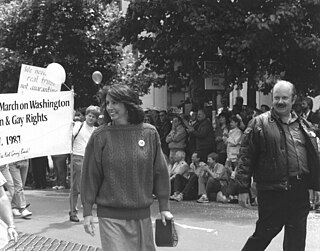
The Second National March on Washington for Lesbian and Gay Rights was a large political rally that took place in Washington, D.C., on October 11, 1987. Its success, size, scope, and historical importance have led to it being called, "The Great March". It marked the first national coverage of ACT UP, with AIDS activists prominent in the main march, as well as making headlines the next day during mass civil disobedience actions at the United States Supreme Court Building.
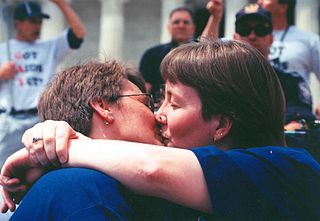
The Millennium March on Washington was an event to raise awareness and visibility of lesbian, gay, bisexual and transgender (LGBT) people and issues of LGBT rights in the US, it was held April 28 through April 30, 2000 in Washington, DC. The Millennium Pride Festival was held prior to the March, it was a huge event that saw tens of thousands flock to the US capital. A march from the Washington Monument to the front lawn of the United States Capitol took place on April 30, where the crowd was addressed by several members of Congress and, via video, by President Bill Clinton. Estimates of attendance ranged from 200,000 to 1 million people. One of the weekend's more successful events was the sellout Equality Rocks concert produced by LGBT rights organization Human Rights Campaign. The concert was held in Washington's RFK Stadium and included stars such as Melissa Etheridge, George Michael, Pet Shop Boys, Garth Brooks, k.d. lang, and Tipper Gore.
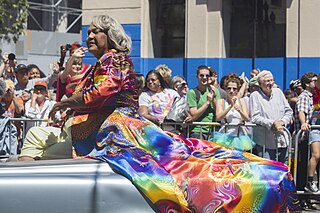
LGBT movements in the United States comprise an interwoven history of lesbian, gay, bisexual, transgender and allied social movements in the United States of America, beginning in the early 20th century. A commonly stated goal among these movements is social equality for LGBT people. Some have also focused on building LGBT communities or worked towards liberation for the broader society from biphobia, homophobia, and transphobia. LGBT movements organized today are made up of a wide range of political activism and cultural activity, including lobbying, street marches, social groups, media, art, and research. Sociologist Mary Bernstein writes: "For the lesbian and gay movement, then, cultural goals include challenging dominant constructions of masculinity and femininity, homophobia, and the primacy of the gendered heterosexual nuclear family (heteronormativity). Political goals include changing laws and policies in order to gain new rights, benefits, and protections from harm." Bernstein emphasizes that activists seek both types of goals in both the civil and political spheres.

The National Equality March was a national political rally that occurred October 11, 2009 in Washington, D.C. It called for equal protection for lesbian, gay, bisexual, and transgender (LGBT) people in all matters governed by civil law in all 50 states and the District of Columbia. The march was called for by activist David Mixner and implemented by Cleve Jones, and organized by Equality Across America and the Courage Campaign. Kip Williams and Robin McGehee served as co-directors. Leaders like actress Michelle Clunie, Courage Campaign marketing director, Billy Pollina and New York gubernatorial aide Peter Yacobellis hosted the first fundraiser in the spring of 2009. This was the first national march in Washington, D.C. for LGBT rights since the 2000 Millennium March.

LGBT history in the United States spans the contributions and struggles of lesbian, gay, bisexual, and transgender (LGBT) people, as well as the LGBT social movements they have built.
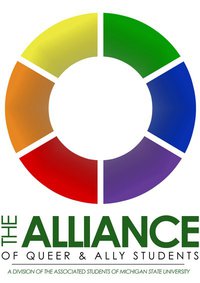
The Alliance of Queer and Ally Students is a student organization for LGBT and straight ally students of Michigan State University. One of the oldest Lesbian, Gay, Bisexual and Transgender groups in Michigan, it began in the early 1970s. First dubbed the Michigan State Gay Liberation Movement (GLM), some sources state the organization began in 1970, while others state it began in 1972.

The first English-language use of the word "bisexual" to refer to sexual orientation occurred in 1892.
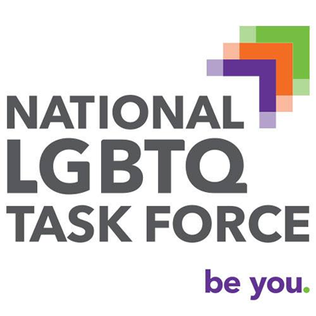
The National LGBTQ Task Force is an American social justice advocacy non-profit organizing the grassroots power of the lesbian, gay, bisexual, transgender, and queer (LGBTQ) community. Also known as The Task Force, the organization supports action and activism on behalf of LGBTQ people and advances a progressive vision of liberation. The past executive director was Rea Carey from 2008-2021 and the current executive director is Kierra Johnson, who took over the position in 2021 to become the first Black woman to head the organization.
This is a timeline of notable events in the history of non-heterosexual conforming people of Asian and Pacific Islander ancestry, who may identify as LGBTIQGNC, men who have sex with men, or related culturally-specific identities. This timeline includes events both in Asia and the Pacific Islands and in the global Asian and Pacific Islander diaspora, as the histories are very deeply linked. Please note: this is a very incomplete timeline, notably lacking LGBTQ-specific items from the 1800s to 1970s, and should not be used as a research resource until additional material is added.
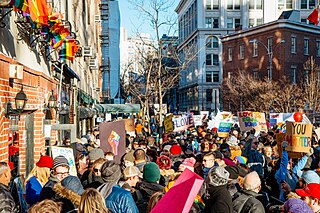
There were several protests organized by the LGBT community against the policies of United States President Donald Trump and his administration.
The National LGBTQ Wall of Honor is a memorial wall in the Greenwich Village neighborhood of Manhattan in New York City, dedicated to LGBTQ "pioneers, trailblazers, and heroes". Located inside the Stonewall Inn, the wall is part of the Stonewall National Monument, the first U.S. National Monument dedicated to the country's LGBTQ rights and history. The first fifty nominees were announced in June 2019, and the wall was unveiled on June 27, 2019, as a part of Stonewall 50 – WorldPride NYC 2019 events. Five honorees will be added annually.

In Washington, D.C., LGBT culture is heavily influenced by the U.S. federal government and the many nonprofit organizations headquartered in the city.















